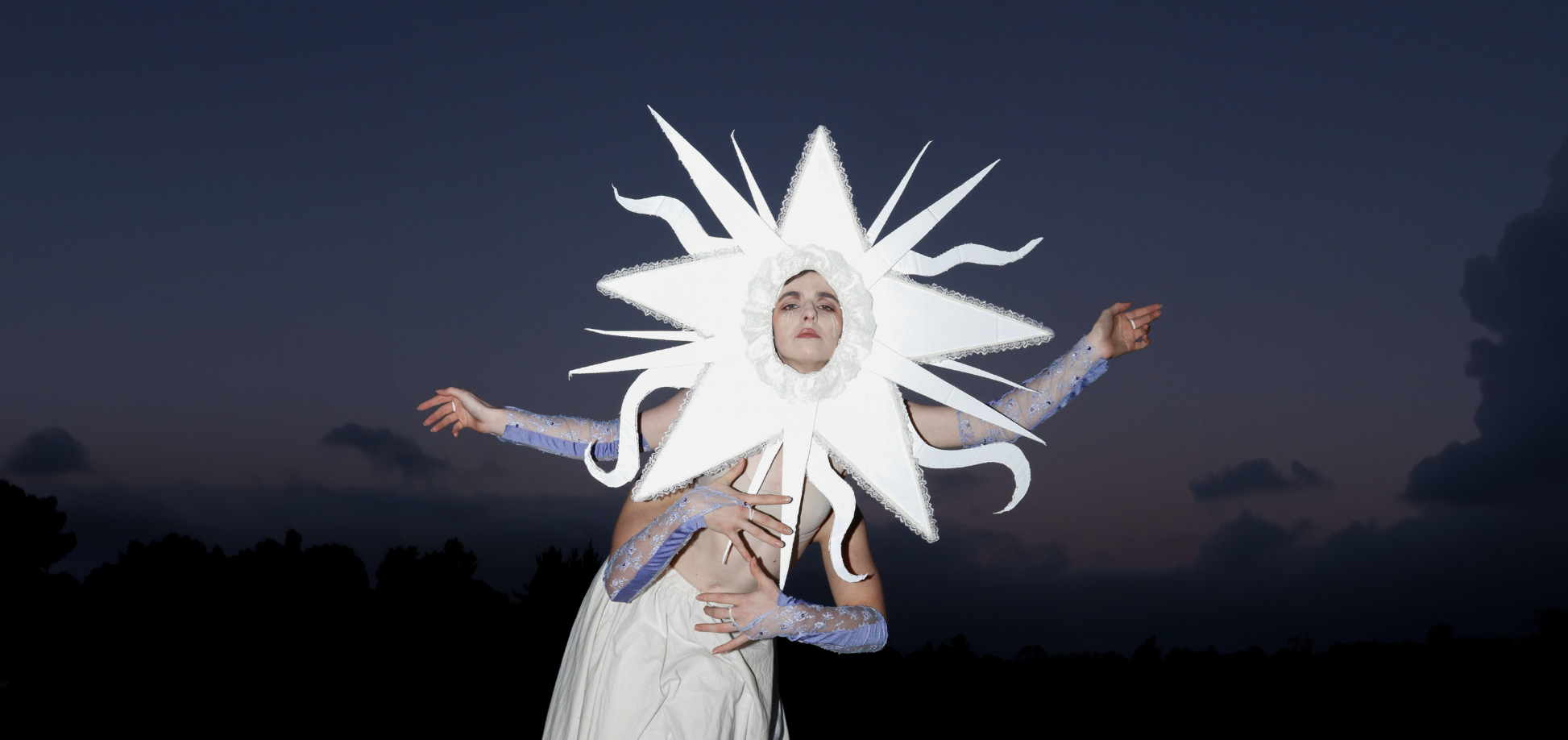On the evening that I arrive at Basement to see Only the Stars Know Where I’ve Been, I have spent two weeks cloistered indoors, alone, with my in-progress manuscript, a box of crackers, and a lovely woman named Tania. I’m perfectly primed to be spirited off-world. And with its surreal dreamscape of cosmic entanglement, turbulent intimacy and a melting dissolution of time itself, Stars fulfils that promise completely.
The black box of Basement Theatre’s studio space serves as backdrop of deepest space to dancers Stella Grace Seawright and Sydney Magnus as they take the stage. They emerge from the house as a haunting single entity, multi-limbed and heaving itself across the floor on hands and feet, while Seawright’s torso rises ethereally from the waist of a white petticoat that conceals the tangled bodies beneath. Their movements are measured, purposeful, strange, clothed in the stark whiteness of distant stars.
The opening scene culminates when the creature comes to a halt, and Seawright unlaces a ribbon woven, corset-like, into their skin. The music thrums beneath the action. An otherworldly undertow with the quality of a thumb being dragged along the lip of a wine glass. It is an image that reverberates with thematic resonance for the show; the navigation of boundaries between flesh and fabric, within and without, self and other.
“With its contrast of precise, sharp motion, and wrenching expression, the choreography by Jake Starrs speaks a language of yearning, contortion, and want.”
As children, our first moments of self-awareness are defined by the point at which ‘I’ ends, and everything else begins. Discovery of this is exhilarating and traumatic in turn. Likewise, from the moment the single creature unravels into two, a tension is born. The new beings embark on a ragged, frenetic search for unity and reconciliation, in a performance that holds space for the beauty and dignity of queer desire. Doubleness abounds throughout the show as the two entities orbit each other like celestial bodies, drawing closer then further away, supporting and thwarting one another in turn. With its contrast of precise, sharp motion, and wrenching expression, the choreography by Jake Starrs speaks a language of yearning, contortion, and want.
Both dancers wear white for the majority of the show, in costumes reminiscent of historical undergarments. However, the classic silhouettes are disrupted by unconventional styling, with each piece draped, wrapped, or executed in peculiar ways. There’s an allusion here, I think; the vulnerability of clothes traditionally worn beneath the exterior, in the act of being close to the skin. But there is also a disrupting of expectations; and a sort of ‘outside of time-ness’ that sits comfortably in the show’s milieu.
This vulnerability sits in stark opposition to the ‘other’ that seems to lurk backstage. Elegantly summarised in the form of a grey woolen coat worn buttoned to the chin, there is a sense that what lies beyond is the grim world of convention, heterosexuality, and structured tailoring. Despite the abstract nature of the show, this visual metaphor lands solidly. There’s a palpable sense of apprehension from the crowd when Magnus first emerges upright, straight-backed and towering in the coat, as Seawright’s character watches silently, warily, from the floor.
In a particularly memorable episode, Magnus performs a seated duet between herself-as-entity and herself-as-the-grey-coat. What ensues is a whirling crescendo of character work. With one hand, she is the tender white-clad entity we’ve seen her embody before; with the other she is a black-gloved, authoritarian—her movements themed around subduing, pushing, grasping the other hand into submission.
It feels at times as if Stars might be following a narrative progression of events, or even that it might have a character arc peeking from behind a veil of graceful motion. But this sense of progress is occasionally foiled by the hard cuts to blackout. The show instead becomes a string of expressive episodes that build in one breath, then dismantle in the next.
As a possible vision of queer temporality, I think the show holds together with some success. When you do not, or can not, achieve the same milestones as heterosexual people, there is a sense that you are not “moving through time” in the way that is expected. Queer temporality then, is a theory that takes this idea and rides off into the sunset with it, suggesting that linear time is a cultural concept and one that can be negotiated (looking at you, daylight savings). In this sense, the disruption of linearity, the lack of build and conclusion, feels intentional and even generous.
However, Stars did occasionally leave me wanting a little more clarity. There were repeated images and motifs that lent some sense of grounding; the image of paired hands, of lacing together and unlacing, in the build and layer of the music. But I must admit that when the lights went up at the very end, I found myself startled awake, unprepared and unconcluded. As if I’d fallen out of bed mid-sentence. As if tipped from the arms of a wonderful dream.



